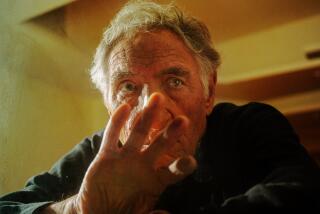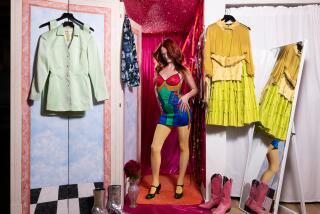Throwing Curves at an American Ideal : The Hourglass Figure Is Back--at Least for Some
- Share via
Tastemakers are sending a message to the American woman who is not overweight but definitely not skinny: Her figure is in again. Bigger, rounder shapes are back. The perfect body is no longer twig-thin, flat-chested and boy-hipped. Rather, it curves in all the places where fashion in the ‘60s and ‘70s dictated straight lines.
Popular magazines are blossoming with models whose silhouettes break the super-thin mold. Two of Sports Illustrated’s most famous bathing-suit models, Czechoslovakia’s Paulina Porizkova and all-American Christie Brinkley, brought womanly cleavage back to the fashion pages, which for years were filled with sundry views of prepubescent-looking girls. And 6-foot-tall, 150-pound Ashley, one of Manhattan’s busiest models, “has a real chest and broad shoulders,” says Mija Strong of New York’s Ford Agency. “She’s not like the old Twiggy look. She looks healthy and has an athletic, well-toned body.”
This revised standard reintroduces a controversy that is raised whenever one “ideal” body is replaced by another. Just as there was resistance when the lush lines of the Gibson girl were pared down to the boyish outline of the flapper, the return of the fuller figure hasn’t been unconditionally accepted by every fashion opinion maker. Designer Bill Blass, for example, says that as far as he’s concerned, the ideal is the same as it’s been since the ‘60s: “The perfect body is thin,” he says. Slim hips and a small bust--”size 8 in the shoulders, a 6 in the hips.”
But Strong maintains that the thin-is-in school of thought is out--if the word thin is not accompanied by conditioned, toned, athletic, defined, muscular, strong. “The size a model wears is irrelevant today,” she says. “The emaciated looks of the ‘60s and ‘70s has been replaced by a stronger, more robust image.”
In the past few years, there have been some changes in the once-immutable measurements for models. Mannequins today can top the 6-foot mark and, like Ashley, have figures measuring about 35-26-37. In the past, models rarely exceeded the rigid 34-23-34 maximum.
Many say that it’s Hollywood, rather than Seventh Avenue, that is behind the trend, and that Madonna’s retro-Monroe image is a perfect example. But the look can be traced to trends that first appeared in the early ‘80s. Jane Fonda in “On Golden Pond,” Jennifer Beals in “Flashdance” and Daryl Hannah in “Splash” were among the first to embody the look of the svelte yet curvaceous woman. Then “Witness” and “Top Gun” star Kelly McGillis began turning heads with her statuesque build, and Vanity Fair magazine nicknamed actress Kathleen Turner the “queen of curves”--and suddenly a new “perfect” silhouette was introduced.
Motion pictures may be more willing to showcase figures that don’t conform to the set-in-stone standards that models usually must meet. Jane Feinberg, vice president of Fenton-Feinberg Casting in Los Angeles, says there is no standard for bodies in the movies. In fact, she says, body type doesn’t factor in motion-picture casting unless “the role demands a perfect body, as in an Arnold Schwarzenegger-type movie. To play opposite a ‘Conan,’ an actress’ physical condition has to be perfect. That’s when you have to come up with a muscular dancer / actress like Sandahl Bergman.”
Feinberg says that standards of beauty for women in the 1950s required them to have one of two types of figures: the 38D or the 34-24-34. “Now it’s the body that has muscle definition. Hollywood expects performers to be in condition. We are buying the whole package--talent, good face, good body.”
Designers and Hollywood executives may be tied to fashion, fads and market trends, but painters and sculptors have aesthetic values based on line, form and proportion. Hiro Yamagata, official artist for last year’s Statue of Liberty celebration, says that shapely, well-proportioned legs are “critical to the beauty of the body.” But he adds that most of a body’s grace comes not from its specific attributes but from how it moves. “Beauty is not static,” he says.
Robert Graham, the Los Angeles sculptor who created the statues that symbolized the 1984 Summer Olympic Games, chose one male and one female athlete as his models. Their torsos--lean, conditioned, robust and defined--have been viewed as the international standard of physical excellence. But are these superb physiques Graham’s personal ideal? Or are rounder forms the new perfect body? The artist quickly dismisses the issue: “No such thing exists.” Dress by H. Lorenzo






